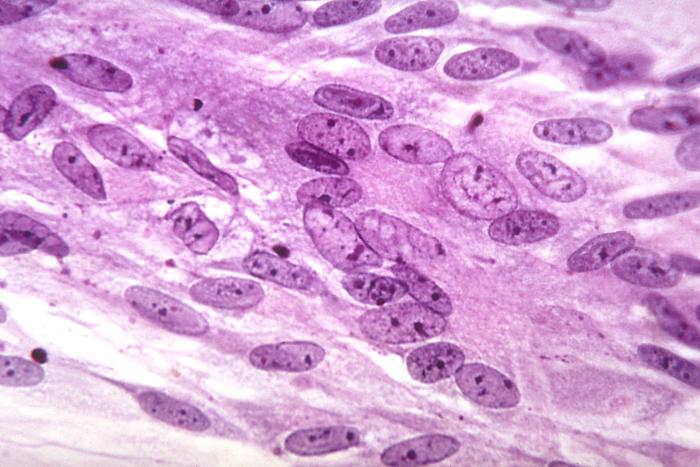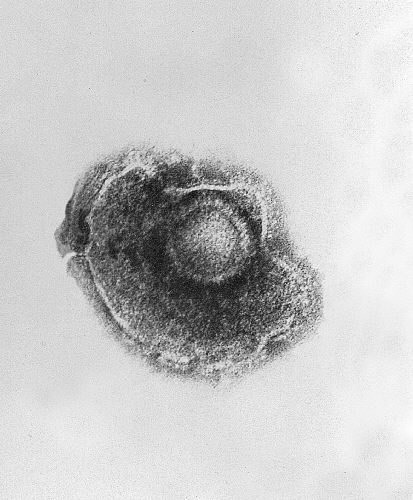Chickenpox pathophysiology: Difference between revisions
No edit summary |
|||
| Line 1: | Line 1: | ||
__NOTOC__ | |||
{{CMG}} | {{CMG}} | ||
{{Chickenpox}} | {{Chickenpox}} | ||
==Pathophysiology== | ==Pathophysiology== | ||
| Line 23: | Line 22: | ||
Chickenpox can also be spread from people with [[shingles]]. Varicella-zoster virus also causes shingles. A person with shingles can spread the virus to others who have never had chickenpox or received the chickenpox vaccine. In these cases, the exposed person might develop chickenpox. | Chickenpox can also be spread from people with [[shingles]]. Varicella-zoster virus also causes shingles. A person with shingles can spread the virus to others who have never had chickenpox or received the chickenpox vaccine. In these cases, the exposed person might develop chickenpox. | ||
====Most | ====Most Contagious?==== | ||
A person with chickenpox can spread the disease from 1 to 2 days before they get the rash until all their chickenpox blisters have formed [[scabs]]. | A person with chickenpox can spread the disease from 1 to 2 days before they get the rash until all their chickenpox blisters have formed [[scabs]]. | ||
| Line 33: | Line 32: | ||
For most people, getting chickenpox once provides [[immunity]] for life. However, for a few people, they can get chickenpox more than once, although this is not common. | For most people, getting chickenpox once provides [[immunity]] for life. However, for a few people, they can get chickenpox more than once, although this is not common. | ||
====Nosocomial | ====Nosocomial Transmission==== | ||
Nosocomial transmission of varicella-zoster virus (VZV) is well-recognized and can be life threatening to certain groups of patients. Reports of nosocomial transmission are relatively uncommon in the United States since introduction of varicella vaccine. | Nosocomial transmission of varicella-zoster virus (VZV) is well-recognized and can be life threatening to certain groups of patients. Reports of nosocomial transmission are relatively uncommon in the United States since introduction of varicella vaccine. | ||
| Line 40: | Line 39: | ||
==References== | ==References== | ||
{{Reflist|2}} | {{Reflist|2}} | ||
[[Category:Needs overview]] | |||
[[Category:Viral diseases]] | |||
[[Category:Pediatrics]] | |||
[[Category:Poxviruses]] | |||
[[Category:Infectious disease]] | |||
[[Category:Overview complete]] | |||
[[Category:primary care]] | |||
{{WikiDoc Help Menu}} | |||
{{WikiDoc Sources}} | |||
Revision as of 20:54, 22 February 2013
Editor-In-Chief: C. Michael Gibson, M.S., M.D. [1]
|
Chickenpox Microchapters |
|
Diagnosis |
|---|
|
Treatment |
|
Case Studies |
|
Chickenpox pathophysiology On the Web |
|
American Roentgen Ray Society Images of Chickenpox pathophysiology |
|
Risk calculators and risk factors for Chickenpox pathophysiology |
Pathophysiology
Chickenpox is usually acquired by the inhalation of airborne respiratory droplets from an infected host. The highly contagious nature of VZV explains the epidemics of chickenpox that spread through schools as one child who is infected quickly spreads the virus to many classmates. High viral titers are found in the characteristic vesicles of chickenpox; thus, viral transmission may also occur through direct contact with these vesicles, although the risk is lower.
After initial inhalation of contaminated respiratory droplets, the virus infects the conjunctivae or the mucosae of the upper respiratory tract. Viral proliferation occurs in regional lymph nodes of the upper respiratory tract 2-4 days after initial infection and is followed by primary viremia on postinfection days 4-6. A second round of viral replication occurs in the body's internal organs, most notably the liver and the spleen, followed by a secondary viremia 14-16 days postinfection. This secondary viremia is characterized by diffuse viral invasion of capillary endothelial cells and the epidermis. VZV infection of cells of the malpighian layer produces both intercellular and intracellular edema, resulting in the characteristic vesicle.
Exposure to VZV in a healthy child initiates the production of host immunoglobulin G (IgG), immunoglobulin M (IgM), and immunoglobulin A (IgA) antibodies; IgG antibodies persist for life and confer immunity. Cell-mediated immune responses are also important in limiting the scope and the duration of primary varicella infection. After primary infection, VZV is hypothesized to spread from mucosal and epidermal lesions to local sensory nerves. VZV then remains latent in the dorsal ganglion cells of the sensory nerves. Reactivation of VZV results in the clinically distinct syndrome of herpes zoster (shingles).
Microscopic Pathology
-
Varicella virus grown in a tissue culture; magnified 500X.
-
Electron micrograph of a varicella (chickenpox) virus.
Transmission
Chickenpox is a very contagious disease caused by the varicella-zoster virus. The virus spreads easily from people with chickenpox to others who have never had the disease or received the chickenpox vaccine. The virus spreads in the air when an infected person coughs or sneezes. It can also be spread by touching or breathing in the virus particles that come from chickenpox blisters.
Chickenpox can also be spread from people with shingles. Varicella-zoster virus also causes shingles. A person with shingles can spread the virus to others who have never had chickenpox or received the chickenpox vaccine. In these cases, the exposed person might develop chickenpox.
Most Contagious?
A person with chickenpox can spread the disease from 1 to 2 days before they get the rash until all their chickenpox blisters have formed scabs.
It takes from 10 to 21 days after exposure to a person with chickenpox or shingles for someone to develop chickenpox.
If a person vaccinated for chickenpox gets the disease, they can still spread it to others.
For most people, getting chickenpox once provides immunity for life. However, for a few people, they can get chickenpox more than once, although this is not common.
Nosocomial Transmission
Nosocomial transmission of varicella-zoster virus (VZV) is well-recognized and can be life threatening to certain groups of patients. Reports of nosocomial transmission are relatively uncommon in the United States since introduction of varicella vaccine.
Patients, health care providers, and visitors with varicella or herpes zoster can spread VZV to susceptible patients and health care providers in hospitals, long-term-care facilities, and other healthcare settings. These transmissions have been attributed to delays in the diagnosis or reporting of varicella and zoster and failures to implement control measures promptly.

